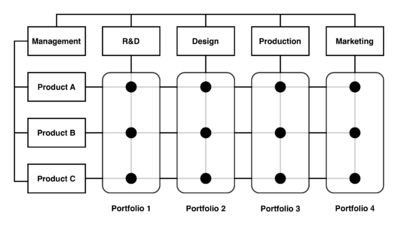Matrix organizations
Created by Martin Sorensen
Contents |
Abstract
A matrix organization utilizes matrix management as its primary organizational structure. Within such an organization, employees have dual reporting relationships and thus report along two central chains of command: one of functional value and another representing a project, product or client.[1] Typically, an employee is associated with a functional manager and a specific project manager. While the functional manager is responsible for the expertise and technical skills of the employees, the project manager is responsible for delivering targeted project outcomes by utilization of those skills. In this manner, the titular matrix is comprised by the various intersections along the two chains of command.
Due to the dual reporting relationship of each employee, the exact organizational form varies depending on the balance of power between the two managers. This balance is described from the perspective of the project manager, and can be either weak, balanced or strong, depending on the amount of authority they hold over the project.
The structure of a matrix organization is intended to address the requirements for companies that operate in dynamic and complex environments. It provides an inherent flexibility by allowing projects to utilise the expertise of all available functional areas within the organization. This enables the company to produce rapid results without the need to realign between each project.
Whilst there are many benefits to matrix organizations, their structural complexity may lead to confusion or internal conflict—especially in the cases where the managerial balance has not been clearly defined.
Big Idea
Matrix organizations are designed to facilitate cross-functional collaboration and improve organizational agility. They are based on the idea that traditional functional structures can create silos and hinder innovation, while project-based structures can be inflexible and lead to duplication of effort. By combining these two approaches, matrix organizations can leverage the strengths of both while mitigating their weaknesses. [2]
Application
Matrix organizations are particularly useful in complex environments where multiple functions or departments need to work together to achieve a common goal. They are often used in project-based industries such as construction, software development, and aerospace, as well as in multinational corporations with diverse product lines and geographically dispersed teams. Successful implementation of a matrix structure requires clear communication channels, well-defined roles and responsibilities, and strong leadership. (Butler & Flynn, 2013)
